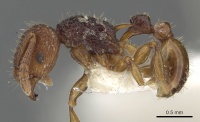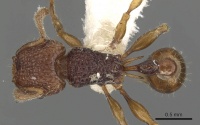Tetramorium zypidum
| Tetramorium zypidum | |
|---|---|

| |
| Scientific classification | |
| Kingdom: | Animalia |
| Phylum: | Arthropoda |
| Class: | Insecta |
| Order: | Hymenoptera |
| Family: | Formicidae |
| Subfamily: | Myrmicinae |
| Tribe: | Crematogastrini |
| Genus: | Tetramorium |
| Species: | T. zypidum |
| Binomial name | |
| Tetramorium zypidum Bolton, 1977 | |
With the exception of a collection from a pitfall-trap in a forest, nothing is known about the biology of Tetramorium zypidum.
Identification
Distribution
Latitudinal Distribution Pattern
Latitudinal Range: 9.316667° to 9.316667°.
| North Temperate |
North Subtropical |
Tropical | South Subtropical |
South Temperate |
- Source: AntMaps
Distribution based on Regional Taxon Lists
Indo-Australian Region: Philippines (type locality).
Distribution based on AntMaps
Distribution based on AntWeb specimens
Check data from AntWeb
Countries Occupied
| Number of countries occupied by this species based on AntWiki Regional Taxon Lists. In general, fewer countries occupied indicates a narrower range, while more countries indicates a more widespread species. |

|
Estimated Abundance
| Relative abundance based on number of AntMaps records per species (this species within the purple bar). Fewer records (to the left) indicates a less abundant/encountered species while more records (to the right) indicates more abundant/encountered species. |

|
Biology
Castes
Worker
  
| |
| . | Owned by Museum of Comparative Zoology. |
Nomenclature
The following information is derived from Barry Bolton's Online Catalogue of the Ants of the World.
- zypidum. Tetramorium zypidum Bolton, 1977: 123, fig. 51 (w.) PHILIPPINES.
Unless otherwise noted the text for the remainder of this section is reported from the publication that includes the original description.
Description
Worker
Bolton (1977) - Holotype. TL 3.8, HL 0.90, HW 0.84, CI 93, SL 0.62, SI 74, PW 0.58, AL 1.04.
Mandibles striate; anterior clypeal margin entire but exceedingly shallowly concave medially. Frontal carinae extending back almost to occipital corners but behind level of eyes becoming very weak, scarcely or not more strongly developed than the other cephalic sculpture. Antennal scrobes shallow and broad, only feebly developed. Occipital margin of head distinctly concave medially in full-face view. Eyes moderate, maximum diameter c. 0'19, the eyes situated in front of the middle of the sides of the head. Dorsal alitrunk evenly, shallowly convex in profile, the propodeal spines long, thick, acute and feebly sinuate along their length, the apices very weakly upcurved. Metapleural lobes narrowly triangular and acute. Shape of petiole in profile as shown in Fig. 51; in dorsal view the node distinctly longer than broad. Dorsum of head predominantly longitudinally rugose with very few cross-meshes to the level of the posterior margins of the eyes, behind this a strong reticulum is developed. Dorsal alitrunk reticulate-rugose. Sides of petiole node with some weak rugosity but the dorsum with an un sculptured median longitudinal strip. Postpetiole and gaster unsculptured. All dorsal surfaces of head and body with quite short erect or suberect hairs. Leading (anterior) margin of antennal scapes with pubescence and also with a spaced row of short, erect hairs. Dorsal (outer) surfaces of hind tibiae with short erect or suberect hairs. Colour reddish brown, the legs dull orange-brown.
Paratypes. As holotype but some slightly lighter in colour, dull orange-brown. Measurements TL 3.3-4.0, HL 0.80-0.98, HW 0.72-0.90, CI 90-94, SL 0.54-0.64, SI 69-75, PW 0.52-0.64, AL 0.90-1.12 (21 measured).
Type Material
Bolton (1977) - Holotype worker, Philippines: Dumaguete, Camp, 14.iv.1931 (J. W. Chapman) (Museum of Comparative Zoology). Paratypes. Philippines: 3 workers with same data as holotype; 6 workers as holotype but 3.iv.1931, no. 11; 3 workers as holotype but iv.l928; 3 workers as holotype but l.iv.1931; 3 workers as holotype but 20.iv.l931; 3 workers, Negros Oriental, Camp, 30.viii.1930 (F. del Rosario) (MCZC; The Natural History Museum; Naturhistorisches Museum, Basel).


